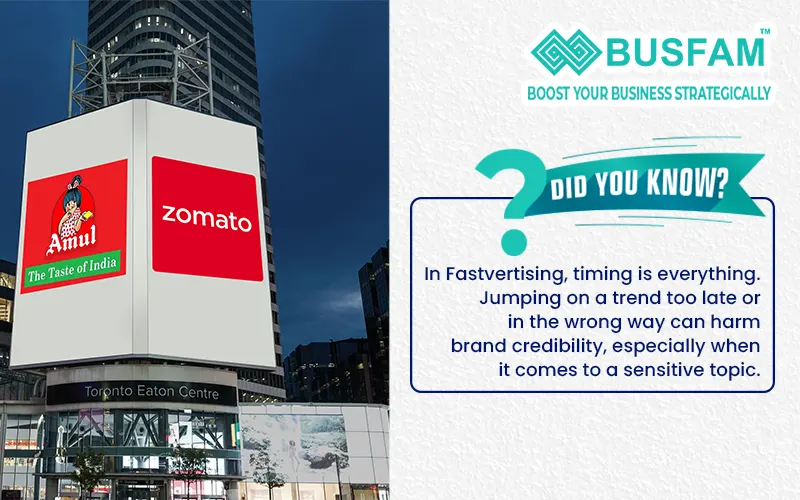

Hello again, readers, to our ever-popular segment #MarketSpotlights, a series presented to you by Team BUSFAM, a professional social media marketing agency.
In our write-up today, we will address the question, "Is the fast-paced age of fastvertising coming to a close in the wake of the Amul and Swiggy controversy?"
There is no denying the fact that the world of advertising is moving at lightning speed. Every brand is coming up with new ideas to stay relevant and capture the attention of the audience. From tweets to memes, brands are now running campaigns within minutes.
One such trend that has been dominating the marketing landscape for quite some time is fastvertising. It is an approach where brands rapidly respond to viral videos, trending topics or breaking news with clever and funny content. It promised high visibility with low investment and a powerful sense of relevance.
But the recent criticism of two brands, such as Amul and Swiggy, which are famous for their moment marketing strategy, has created a controversy: "Is the age of fastvertising finally coming to an end, or is it time to take a pause?
Let’s find out.
Fastvertising emerged alongside the rise of social media platforms like Twitter, Instagram, and later TikTok, which have greatly transformed the way brands communicate with audiences.
As consumers are hyper-social and digitally connected, real-time engagement with the audience has grown rapidly. Almost every brand shifted its focus to publishing campaigns as a quick response to a new trending topic.
This allowed brands to engage in online conversations in a way that felt relatable. The interactions not only increased their visibility but also helped them build a responsive image.
Amul: The renowned dairy brand is greatly admired for its creativity in responding to events related to politics, entertainment, sports and more.
Swiggy: The food ordering and delivery company online is cashing in on the trend. They have been creating campaigns based on clever posts, laughable content, and instant responses on Twitter to catch social media buzz.
Zomato: It is also an online food ordering and delivery company that is famous for catchy push messages. Their relatable content is what keeps them trending.

In Fastvertising, timing is everything. Jumping on a trend too late or in the wrong way can harm brand credibility, especially when it comes to a sensitive topic.
While Amul's take on the kiss controversy at the Coldplay concert was witty, it was slammed for capitalising on a sensitive moment.
Amul released an ad with the line "Hum tum ek camera mein bandh ho," accompanied by cartoon faces of Astronomer's CEO, Andy Byron, and Chief People Officer, Kristin Cabot.
The advertisement was questioned on the grounds of brand accountability. It was cited as an example of the recklessness of marketing strategy for commercial benefit.
Moreover, Swiggy's Teej ad, which included a Bollywood song, also did not go well with the audience due to cultural insensitivity. The lyrics "Tu Cheez Badi Hai Mast Mast" to advertise their services were criticised for objectifying women and showed the brand's negligence in the significance of the Teej festival.
Fastvertising is only an effective advertising tool when used responsibly. What may have worked for certain trending events may not be appropriate for any other occasion, particularly for consumers who are conscious and always ready to call out the brand.
Marketing professionals advise brands to craft sensible campaigns not only for entertainment but also to connect with today's audience.
They must realise that not every trend requires a response; rather, they should choose the one that aligns with their goals. Furthermore, fast response is justifiable, but at no cost of empathy and social awareness when it comes to cultural, political or emotional context.
So, is fastvertising dying? Not exactly.
But brands are certainly in the spotlight, particularly in the online age, where their audiences are more vocal. Brands are required to be not only creative but also thoughtful.
Therefore, it won’t be wrong to say that the future of marketing lies in the perfect balance between relevance and responsibility.